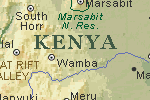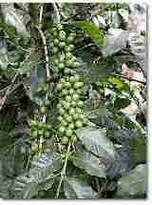Main menu:
Kenya
Introduction |
||
Flag: |
|
|
Card: |
||
Background: |
Revered president and liberation struggle icon Jomo KENYATTA led Kenya from independence until his death in 1978, when current President Daniel Toroitich arap MOI took power in a constitutional succession. The country was a de facto one-party state from 1969 until 1982 when the ruling Kenya African National Union (KANU) made itself the sole legal party in Kenya. MOI acceded to internal and external pressure for political liberalization in late 1991. The ethnically fractured opposition failed to dislodge KANU from power in elections in 1992 and 1997, which were marred by violence and fraud, but are viewed as having generally reflected the will of the Kenyan people. The country faces a period of political uncertainty because MOI is constitutionally required to step down at the next elections that have to be held by early 2003. |
|
Geography |
||
Location: |
Eastern Africa, bordering the Indian Ocean, between Somalia and Tanzania |
|
Coordinates: |
1° 00' N, 38° 00' E |
|
Map references: |
Africa |
|
Area: |
total: 582,650 sq km |
|
Land boundaries: |
total: 3,446 km |
|
Climate: |
varies from tropical along coast to arid in interior |
|
Terrain: |
low plains rise to central highlands bisected by Great Rift Valley; fertile plateau in west |
|
Markmale: |
niedrigster Punkt: Indischer Ozean 0 m |
|
Elevation extremes: |
lowest point: Indian Ocean 0 m |
|
Geography - note: |
the Kenyan Highlands comprise one of the most successful agricultural production regions in Africa; glaciers on Mt. Kenya; unique physiography supports abundant and varied wildlife of scientific and economic value. |
|
People |
||
Population: |
30,765,916 |
|
note: |
estimates for this country explicitly take into account the effects of excess mortality due to AIDS; this can result in lower life expectancy, higher infant mortality and death rates, lower population and growth rates, and changes in the distribution of population by age and sex than would otherwise be expected (July 2001 est.) |
|
Nationality: |
noun: Kenyan(s) |
|
Ethnic groups: |
Kikuyu 22%, Luhya 14%, Luo 13%, Kalenjin 12%, Kamba 11%, Kisii 6%, Meru 6%, other African 15%, non-African (Asian, European, and Arab) 1% |
|
Religions: |
Protestant 38%, Roman Catholic 28%, indigenous beliefs 26%, Muslim 7%, other 1% |
|
Languages: |
English (official), Kiswahili (official), numerous indigenous languages |
|
Government |
||
Country name: |
conventional long form: Republic of Kenya |
|
Government type: |
Republic |
|
Capital: |
Nairobi |
|
National holiday: |
Independence Day, 12 December (1963) |
|
Constitution: |
12 December 1963, amended as a republic 1964; reissued with amendments 1979, 1983, 1986, 1988, 1991, 1992, and 1997 |
|
Flag description: |
three equal horizontal bands of black (top), red, and green; the red band is edged in white; a large warrior's shield covering crossed spears is superimposed at the center |
|
Economy |
||
Economy - overview: |
Kenya is well placed to serve as an engine of growth in East Africa, but its economy has been stagnating because of poor management and uneven commitment to reform. In 1993, the government of Kenya implemented a program of economic liberalization and reform that included the removal of import licensing, price controls, and foreign exchange controls. With the support of the World Bank, IMF, and other donors, the reforms led to a brief turnaround in economic performance following a period of negative growth in the early 1990s. Kenya's real GDP grew 5% in 1995 and 4% in 1996, and inflation remained under control. Growth slowed after 1997, averaging only 1.5% in 1997-2000. In 1997, political violence damaged the tourist industry, and Kenya's Enhanced Structural Adjustment Program lapsed due to the government's failure to maintain reform or address public sector corruption. Severe drought in 1999 and 2000 caused water and energy rationing and reduced agricultural sector productivity. A new economic team was put in place in 1999 to revitalize the reform effort, strengthen the civil service, and curb corruption. The IMF and World Bank renewed their support to Kenya in mid-2000, but a number of setbacks to the economic reform program in late 2000 have renewed donor and private sector concern about the government's commitment to sound governance. Long-term barriers to development include electricity shortages, inefficient government dominance of key sectors, endemic corruption, and high population growth. |
|
Industries: |
small-scale consumer goods (plastic, furniture, batteries, textiles, soap, cigarettes, flour), agricultural products processing; oil refining, cement; tourism |
|
Agriculture - products: |
coffee, tea, corn, wheat, sugarcane, fruit, vegetables; dairy products, beef, pork, poultry, eggs |
|
Currency: |
Shilling Kenyan (KES) |
|
Currency code: |
KES |
|
Transportation |
||
Railways: |
total: 2,778 km |
|
Ports and harbors: |
Kisumu, Lamu, Mombasa |
|
Coffee |
||
|
||
Coffee Farms: |
573,426 farms grouped into 275 cooperatives,1,275 plantations |
|
Coffee Workers: |
6,000,000 |
|
Shade Grown: |
Rarely |
|
Major Coffee Growing Regions: |
High Plateau around Mt. Kenya,Aberdare Zone,West: Kasii, Nyanza, Bungoma, East: Nakuru, Kericho |
|
Botanical Cultivars: |
Bourbon,Kents, Typica,Riuri 11 |
|
Harvest Times: |
Main Crop: October-December,Fly Crop: June-August |
|
Grading, |
AA (17/18 screen)=highestM'buni, natural coffee for local consumption=lowest:Wet-processing |
|
Certified Organic: |
None. Localized use of chemicals is rare, due to excellent agricultural methods: mulching, pruning, mowing etc. |
|
Rank in Production:: |
6th in Africa18th in World |
|
Introduced: |
1800's: By the Fathers of the Holy Spirit Congregation: Bourbon in 1911 from Reunion: Kents in 1920 from the Indies. |
|
Growing-areas: |
North and south of Nairobi , high plateaus surrounding Mt Kenyain the Aberdare zones west of the Kisu district |
|
Qualities: |
washed Arabicas classified as per beansize and cup |
|
Altitude: |
1.500 to 2.200 meter |
|
Harvest: |
Flycrop: |
Juny - August |
Shippingperiod: |
Flycrop: |
Juliy - September |
Port of Export: |
Mombasa |
|
Shipment: |
in container in bags (upto 320 of 60.- kos net each) |
|
Production: |
918,000 bags |
|
Export figures: |
817,125 bags |
|
Special remarks: |
all coffees are bought in the auction from the Kenian Coffee Board |
|
Caffeine content: |
1.36 % |
|













